Hazard Identification Training Tool
How to Play
Currently, the user can choose between four different scenarios: "OSHA Visual Inspection Training", "Manufacturing", "Construction" and "Emergency Room". To view specific workplace operations, OSHA recommends playing the "OSHA Visual Inspection Training" scenario first. This scenario focuses on the visual inspection component to identify specific hazards as opposed to the larger hazard identification process.
Note: The hazards in each of these scenarios are randomized so a user can play each scenario multiple times with different hazard combinations appearing.
OSHA Visual Inspection Training
In the "OSHA Visual Inspection Training" scenario, which contains a saw, industrial chemical mixer, scaffolding and fall protection for inspection; users learn how to identify hazards on items found in the workplace; become familiar with typical hazard categories; and understand common relationships of hazards to equipment components and operations.
OSHA Visual Inspection Training Game Play: The OSHA Visual Inspection Training offers the user an opportunity to practice a visual inspection and find hazards. In this scenario, the user can view equipment from 360° to look for hazards. The user can also talk to the employee and observe the employee at work to identify additional hazards. Once hazards are identified, the user checks the box in the log.

Manufacturing, Construction Facility and Emergency Room
To experience the entire workplace, select the "Manufacturing", "Construction" or "Emergency Room" scenarios which focus on the principal skills needed to effectively identify hazards in the workplace and reinforces the key components in the hazard identification process. The process components are:
-
Collect information: Read any information that users may have at their workplace (manuals, safety data sheets, OSHA data, etc.) to find hazards that have already been identified by others.
-
Inspect workplace: The most basic (yet important) component of inspection is the simple visual inspection. Inspecting the equipment and the surrounding work areas allows the user to look over the equipment without any obstructions that might exist while the equipment is being operated. Certain hazards might only be recognizable when the machine is not in operation.
-
Observe the operation: Another good way to identify hazards during an inspection is to observe the equipment in operation. Watch the operator and note any hazardous situations. Observing an operation gives the viewer an opportunity to see how the task is actually completed. This can provide insight on additional hazards that would not be recognizable otherwise (positioning of controls relative to the worker, noise and dust levels, by-passing or improper use of safety functions). This can only be done when workers are present and production is underway.
-
Investigate incidents: Whenever an incident occurs, use that as an opportunity to learn about hazards that may have been overlooked.
-
Involve employees: A great way to gain insight into workplace hazards is to talk to the equipment operators. Often, they are aware of issues that may not be apparent during an inspection. Talk to the workers and listen to their feedback.
Manufacturing
Manufacturing Game Play: The manufacturing scenario offers user the option of playing two different ways; as the business owner or as a worker who is part of the safety committee in a hovercraft parts manufacturing facility.
Business Owner: From week to week, the user must identify and fix hazards to maintain a safe workplace, but these activities cost time and money. The user is given 40 hours per week to address safety in the workplace and build profits. The user determines how much time to spend on ensuring a safe and healthful work environment and how much to dedicate to making money. Any hazard in the workplace can lead to accidents and money will be deducted from profits when accidents occur as the result of uncontrolled hazards. The object is to make as much as possible in 20 weeks while keeping your workers safe.
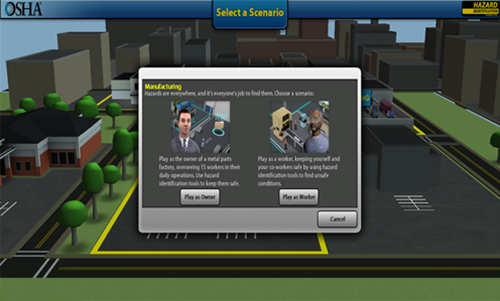
Worker: As a member of the workplace's safety committee the user is given 10 hours to find hazards in one area of the facility. The user can talk to co-workers, inspect and observe the equipment and area or review other sources of information such as manuals, SDS's or OSHA data to find the hazards. The goal is to identify as many hazards as possible throughout the area to help maintain a safe workplace.
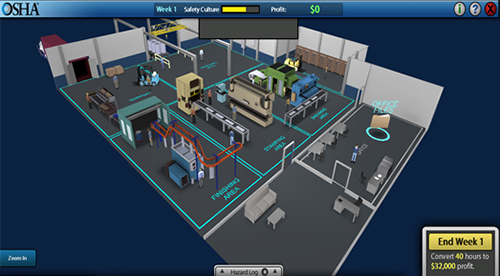
Construction
Construction Game Play: The user must identify and mitigate hazards to maintain a safe workplace throughout three phases of a construction project, but these activities cost time and money. The user is given 10 days for each phase, with a maximum of 480 minutes per day, to address safety in the workplace and build profits. The user determines how much time to allocate to ensure a safe and healthful work environment and how much to allocate to making money. Any hazard in the workplace can lead to accidents and money will be deducted from profits when accidents occur as the result of unmitigated hazards. The object is to make as much as possible in the 30 days it will take to complete the building while keeping your workers safe.
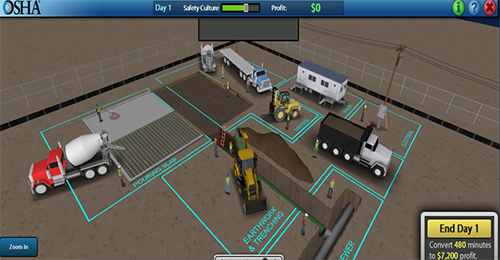
Emergency Room
Emergency Room Game Play: The emergency room scenario offers user the option of playing two different ways; as the supervisor or as a worker who is part of the safety committee in a mid-sized ER.
Owner: From week to week, the user must identify and fix hazards to maintain a safe workplace, but these activities cost time and money. The user is given 40 actions per week to address safety in the workplace and keep the budget surplus high. The user determines how much time to spend on ensuring a safe and healthful work environment and how much to dedicate to increasing the budget surplus. Any hazard in the workplace can lead to accidents and money will be deducted from the budget when accidents occur as the result of uncontrolled hazards. The object is to have as high a surplus possible in 20 weeks while keeping your workers safe.
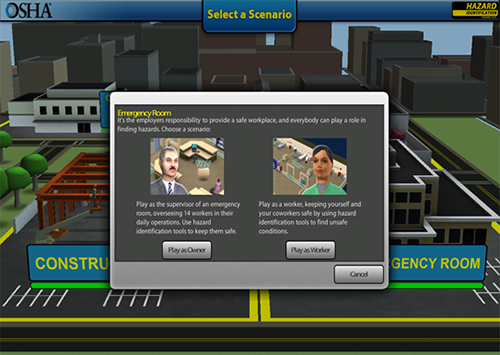
Worker: As a member of the workplace's safety committee the user is given 10 hours to find hazards in one area of the facility. The user can talk to co-workers, inspect and observe the equipment and area or review other sources of information such as manuals, SDS's or OSHA data to find the hazards. The goal is to identify as many hazards as possible throughout the area to help maintain a safe workplace.
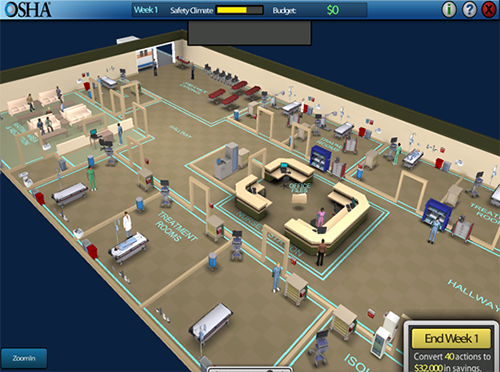
Fixing Hazards in the Scenarios
While this tool is primarily intended to teach users how to identify hazards in their workplace, OSHA has included an element which allows users to remove those hazards from the workplace. This component is designed to enhance the playability of the tool and is in no way intended to require users to remove or control hazards using any specific control method. OSHA realizes that a business owner may choose to implement multiple control strategies to thoroughly address an individual occupational hazard in their workplace, but for the purposes of this tool, users are limited to selecting one non-specific control method for each hazard.
OSHA also recognizes that, in practice, one control strategy may correct multiple hazards in the workplace. This feature has not been incorporated into the tool because the focus of the tool is, first and foremost, to teach users the methods of how to identify hazards, rather than how to fix them.


